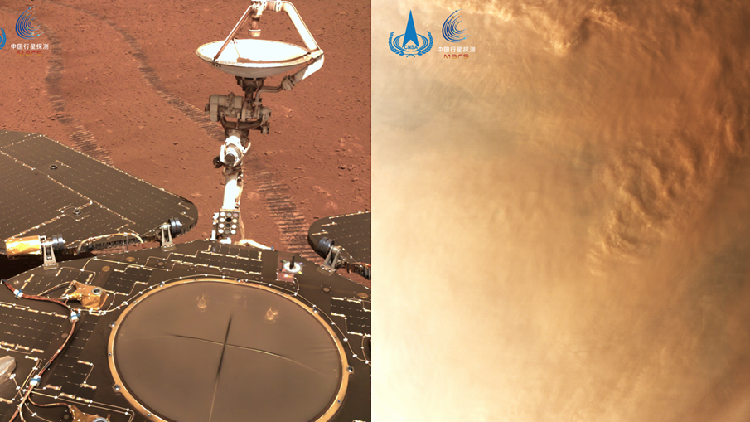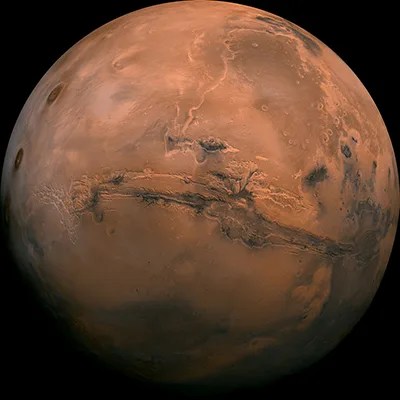Du verwendest einen veralteten Browser. Dieser kann eventuell diese oder andere Webseiten nicht richtig darstellen.
Du solltest deinen Browser aktualisieren oder einen alternativen Browser verwenden.
Du solltest deinen Browser aktualisieren oder einen alternativen Browser verwenden.
Mars-Missionen 2020
- Ersteller des Themas P_E_T_E_R
- Erstellungsdatum
- Status
- Es sind keine weiteren Antworten möglich.
jbrachte
Aktives Mitglied
Zhurong hat jetzt ungefähr 800 Meter zurückgelegt. Dabei mußte er teils schwieriges Terrain überwinden (Senken, Dünen, Geröll). Auf diesem Foto, das mit der rückwärtigen Kamera aufgenommen wurde, sieht man anhand der Spuren, wie er größeren Steinen ausweicht und kleinere überrollt.
http://www.xinhuanet.com/tech/2021-08/06/c_1127736686.htm
Viele Grüße
Johannes
http://www.xinhuanet.com/tech/2021-08/06/c_1127736686.htm
Viele Grüße
Johannes
ThN
Aktives Mitglied
Perseverance hat Schwierigkeiten beim Bohren:
" On Mars, you don't always make a "hole in one."
@NASAPersevere 's attempt at sample collection today ended with no
sample in the tube. After the team reviews data to determine the cause,
we’ll move forward with a next attempt."
Thomas
" On Mars, you don't always make a "hole in one."
@NASAPersevere 's attempt at sample collection today ended with no
sample in the tube. After the team reviews data to determine the cause,
we’ll move forward with a next attempt."
Thomas
P_E_T_E_R
Aktives Mitglied
Perseverance came up empty on its first attempt to grab and stow a sample of Mars
The sampling process is autonomous, meaning that once a sample site is selected the rover carries out the operation on its own. The Sampling and Caching System worked as expected last week: The system uses a percussive drill along with a hollow coring bit at the end of its 2-meter-long (7 feet) robotic arm to collect chalk-sized sample cores.
However, after the core is placed in the tube, the probe measures the volume of the sample collected. And on this first attempt, the probe did not encounter the resistance engineers expected to see from a filled tube, suggesting that it was in fact, empty. The view from the Sampling and Caching System camera backs up this assertion:

The view from the caching system's camera, which looked down an empty sample tube after the first collection attempt.
Credit: NASA / JPL-Caltech
The sampling process is autonomous, meaning that once a sample site is selected the rover carries out the operation on its own. The Sampling and Caching System worked as expected last week: The system uses a percussive drill along with a hollow coring bit at the end of its 2-meter-long (7 feet) robotic arm to collect chalk-sized sample cores.
However, after the core is placed in the tube, the probe measures the volume of the sample collected. And on this first attempt, the probe did not encounter the resistance engineers expected to see from a filled tube, suggesting that it was in fact, empty. The view from the Sampling and Caching System camera backs up this assertion:
The view from the caching system's camera, which looked down an empty sample tube after the first collection attempt.
Credit: NASA / JPL-Caltech
MiMeDo
Aktives Mitglied

Assessing Perseverance's First Sample Attempt - NASA Science
After the commands for sol 164 were sent for the first sample acquisition and processing on the target Roubion, it was time to take some hours off and begin waiting for the result.
P_E_T_E_R
Aktives Mitglied
jbrachte
Aktives Mitglied
Zhurong hat inzwischen seine vorgesehene Funktionsdauer von 90 Marstagen erreicht und alle vorgesehenen wissenschaftlichen Aufgaben erledigt. Er funktioniert aber noch gut und wird weiter das Gelände in Planitia Utopia erkunden, insbesondere die Grenze zwischen dem (früheren) Meer und dem (früheren) Ufer.
http://www.xinhuanet.com/english/2021-08/18/c_1310132968.htm
Von Mitte September bis Ende Oktober werden der Rover Zhurong und der Orbiter Tianwen in den Ruhezustand versetzt, denn dann steht die Sonne zwischen Mars und Erde, so daß keine Signalübertragung möglich ist.
Viele Grüße
Johannes
http://www.xinhuanet.com/english/2021-08/18/c_1310132968.htm
Von Mitte September bis Ende Oktober werden der Rover Zhurong und der Orbiter Tianwen in den Ruhezustand versetzt, denn dann steht die Sonne zwischen Mars und Erde, so daß keine Signalübertragung möglich ist.
Viele Grüße
Johannes
MiMeDo
Aktives Mitglied
Und nicht nur die Neulinge, auch der (die?) neun Jahre alte Curiosity fährt durch spektakuläre Landschaften!

 www.jpl.nasa.gov
www.jpl.nasa.gov

 www.youtube.com
www.youtube.com
Gruss
Thorsten

NASA’s Curiosity Mars Rover Explores a Changing Landscape
A new video rings in the rover’s ninth year on Mars, letting viewers tour Curiosity’s location on a Martian mountain.

NASA’s Curiosity Mars Rover Finds A Changing Landscape
NASA’s Curiosity rover explores Mount Sharp, a 5-mile-tall (8-kilometer-tall) mountain within the basin of Gale Crater on Mars. Curiosity’s Deputy Project Sc...
Gruss
Thorsten
ThN
Aktives Mitglied
Scott Manley mit einem Update für Chinas Rover Zhurong:

 www.youtube.com
www.youtube.com
Thomas

China's Mars Rover Zhurong Has Completed Its Primary Mission, Reaches New Milestone
Zhurong is the name given to the Chinese Space Agency's Mars rover mission, and after landing in May it's spent over 90 days traversing the surface of Utopia...
Thomas
jbrachte
Aktives Mitglied
Tianwen 1, der chinesische Mars-Orbiter, hat einige neue Fotos von sich selbst und vom Mars geschickt:
 www.cnsa.gov.cn
www.cnsa.gov.cn
Viele Grüße
Johannes
Chinese Mars mission sends photos of the Red Planet
 www.cnsa.gov.cn
www.cnsa.gov.cn
Viele Grüße
Johannes
jbrachte
Aktives Mitglied
Tianwen 1, der chinesische Mars-Orbiter, hat mithilfe eine selfie-stick sich selbst vor dem Mars gefilmt. Hier das kurze Video, das heute, pünktlich zum chinesischen Neujahrsfest, vom Mars geschickt wurde:

 www.youtube.com
www.youtube.com
Viele Grüße
Johannes

Tianwen-1 orbiter deploys âselfie stickâ
On 31 January 2022, the China National Space Administration (CNSA) released new video footage from the Tianwen-1 Mars mission. The Tianwen-1 orbiter has depl...
Viele Grüße
Johannes
P_E_T_E_R
Aktives Mitglied
Die Planung für den Transport der von Perseverance einzusammelnden Bodenproben ist jetzt einen weiteren Schritt vorangekommen. Es gibt einen Auftrag der NASA an Lockheed-Martin zur Bereitstellung des MAV = Mars Ascent Vehicle, einer leichten Rakete, mit der die Bodenproben zunächst in einen Mars-Orbit gebracht werden sollen:
Lockheed Martin wins NASA contract to bring Mars samples back to Earth
According to the space agency's plans, a mission will be launched in 2026 at the earliest to send the mini-rocket to Mars, carrying another rover responsible for collecting the samples left behind by Perseverance.
Once the samples are placed in the rocket, it will take off and put them in orbit around Mars. They will then be captured by another vessel sent there to complete the final leg of the journey back to Earth.
This last vessel, as well as the rover that will recover the samples, are being developed under the direction of the European Space Agency.
Im Orbit soll die Kapsel mit den Proben dann in den Earth Return Orbiter der ESA umgeladen und zur Erde gebracht werden.
ESA Mars sample return
Lockheed Martin wins NASA contract to bring Mars samples back to Earth
According to the space agency's plans, a mission will be launched in 2026 at the earliest to send the mini-rocket to Mars, carrying another rover responsible for collecting the samples left behind by Perseverance.
Once the samples are placed in the rocket, it will take off and put them in orbit around Mars. They will then be captured by another vessel sent there to complete the final leg of the journey back to Earth.
This last vessel, as well as the rover that will recover the samples, are being developed under the direction of the European Space Agency.
Im Orbit soll die Kapsel mit den Proben dann in den Earth Return Orbiter der ESA umgeladen und zur Erde gebracht werden.
ESA Mars sample return
jbrachte
Aktives Mitglied
Der chinesische Mars-Orbiter hat hoch aufgelöste Fotos von der Marsoberfläche geschickt. Man sieht sehr schön die Fahrspuren des Marsrovers Zhurong.
Zhurong hat auch seine eigenen Solarpenele fotografiert. Sie zeigen, wie viel roter Staub sich darauf inzwischen angesammelt hat.

 news.cgtn.com
news.cgtn.com
Viele Grüße
Johannes
Zhurong hat auch seine eigenen Solarpenele fotografiert. Sie zeigen, wie viel roter Staub sich darauf inzwischen angesammelt hat.

China's Mars orbiter sends back high-resolution images
Viele Grüße
Johannes
ThN
Aktives Mitglied
Anscheinend hat Perseverence vielversprechende organische Moleküle in seinem (ihrem?) neuesten Untersuchungsterrain gefunden:

 mars.nasa.gov
mars.nasa.gov
Thomas

Mars: News & Features - NASA Science
Get the latest news releases, features, findings, and stories about the missions on Mars.
Thomas
Zuletzt bearbeitet:
Ehemaliges Mitglied 8776
ThN
Aktives Mitglied
Waa'ts ab, @P_E_T_E_R , vielleicht sinds ja große Erdölvorkommen. Dann wäre das Energieproblem der zukünftigen Mars-Kolonisten gelöst und das freiwerdende CO2 bewirkt ein Terraforming!
Thomas
Thomas
P_E_T_E_R
Aktives Mitglied
Uups!Und wenn man außerdem noch Wasser fände?

Dass es auf dem Mars sogar riesige Mengen an Wassereis gibt, und zwar an den Polen, ist ja nun wirklich nichts Neues:Hat man doch gefühlt schon einmal pro Jahr...
Martian polar ice caps
The caps at both poles consist primarily of water ice. Frozen carbon dioxide accumulates as a comparatively thin layer about one metre thick on the north cap in the northern winter, while the south cap has a permanent dry ice cover about 8 m thick.
The northern polar cap has a diameter of about 1000 km during the northern Mars summer, and contains about 1.6 million cubic km of ice, which if spread evenly on the cap would be 2 km thick. The southern polar cap has a diameter of 350 km and a thickness of 3 km. The total volume of ice in the south polar cap plus the adjacent layered deposits has also been estimated at 1.6 million cubic km.
ThN
Aktives Mitglied
Nee - so meinte ich das nicht (Leute, wie lang bin ich schon hier dabei?) ... Es ging doch um CO2-Generierung aus Ölvorkommen auf dem Mars. Und @MiMeDo meinte richtigerweise dass man noch Sauerstoff braucht und Wasser ist H2O... (Brauchen wir aber nicht weiter vertiefen ?
Wenn ich den Artikel richtig verstanden habe, werden wir sowieso erst genaueres erfahren, wenn die Probe zur Erde zurückgekehrt ist...
Thomas
Wenn ich den Artikel richtig verstanden habe, werden wir sowieso erst genaueres erfahren, wenn die Probe zur Erde zurückgekehrt ist...
Thomas
P_E_T_E_R
Aktives Mitglied
Und was hat es mit dem ganzen "fuss" über mögliche organische Signaturen auf sich?
Perseverance hat unter anderem ein Instrument mit dem Akronym SHERLOC, was eine Abkürzung für die etwas sperrige Bezeichnung "Scanning Habitable Environments with Raman and Luminescence for Organics and Chemicals" darstellt. Das Ding hat einen UV-Laser, mit dem es Bodenproben beleuchtet und dann mit Raman Spektroskopie auf charakteristische Signaturen von organischen Verbindungen untersucht.
Perseverance Rover Investigates Geologically Rich Mars Terrain
Jezero Crater hosts a delta – an ancient fan-shaped feature that formed about 3.5 billion years ago at the convergence of a Martian river and a lake. Perseverance is currently investigating the delta’s sedimentary rocks, formed when particles of various sizes settled in the once-watery environment.
SHERLOC’s analysis indicates the samples feature a class of organic molecules that are spatially correlated with those of sulfate minerals. Sulfate minerals found in layers of sedimentary rock can yield significant information about the aqueous environments in which they formed.
Aber, hier kommt das Caveat:
Organic molecules consist of a wide variety of compounds made primarily of carbon and usually include hydrogen and oxygen atoms. They can also contain other elements, such as nitrogen, phosphorus, and sulfur. While there are chemical processes that produce these molecules that don’t require life, some of these compounds are the chemical building blocks of life. The presence of these specific molecules is considered to be a potential biosignature – a substance or structure that could be evidence of past life but may also have been produced without the presence of life.
S&T - Perseverance finds ancient habitable conditions (but not yet life) on Mars
Perseverance hat unter anderem ein Instrument mit dem Akronym SHERLOC, was eine Abkürzung für die etwas sperrige Bezeichnung "Scanning Habitable Environments with Raman and Luminescence for Organics and Chemicals" darstellt. Das Ding hat einen UV-Laser, mit dem es Bodenproben beleuchtet und dann mit Raman Spektroskopie auf charakteristische Signaturen von organischen Verbindungen untersucht.
Perseverance Rover Investigates Geologically Rich Mars Terrain
Jezero Crater hosts a delta – an ancient fan-shaped feature that formed about 3.5 billion years ago at the convergence of a Martian river and a lake. Perseverance is currently investigating the delta’s sedimentary rocks, formed when particles of various sizes settled in the once-watery environment.
SHERLOC’s analysis indicates the samples feature a class of organic molecules that are spatially correlated with those of sulfate minerals. Sulfate minerals found in layers of sedimentary rock can yield significant information about the aqueous environments in which they formed.
Aber, hier kommt das Caveat:
Organic molecules consist of a wide variety of compounds made primarily of carbon and usually include hydrogen and oxygen atoms. They can also contain other elements, such as nitrogen, phosphorus, and sulfur. While there are chemical processes that produce these molecules that don’t require life, some of these compounds are the chemical building blocks of life. The presence of these specific molecules is considered to be a potential biosignature – a substance or structure that could be evidence of past life but may also have been produced without the presence of life.
S&T - Perseverance finds ancient habitable conditions (but not yet life) on Mars
- Status
- Es sind keine weiteren Antworten möglich.